อุบัติการณ์ของการติดเชื้อในระบบทางเดินปัสสาวะที่สัมพันธ์กับการใส่สายสวนปัสสาวะ ในผู้ป่วยที่เข้ารับการรักษาในแผนกผู้ป่วยใน ณ โรงพยาบาลมหาวิทยาลัยบูรพา
คำสำคัญ:
การใส่สายสวนปัสสาวะ , การติดเชื้อในระบบทางเดินปัสสาวะอันเนื่องมาจากการใส่สายสวนปัสสาวะ , การมีแบคทีเรียในปัสสาวะแบบไม่ปรากฏอาการอันเนื่องมาจากการใส่สายสวนปัสสาวะบทคัดย่อ
บริบท การติดเชื้อทางเดินปัสสาวะจากการใส่สายสวนปัสสาวะในโรงพยาบาลพบได้บ่อย ทำให้ผู้ป่วยต้องรับการรักษาในโรงพยาบาลเป็นระยะเวลานานขึ้น และมีความเสี่ยงต่อภาวะแทรกซ้อน
วัตถุประสงค์ เพื่อศึกษาอุบัติการณ์การติดเชื้อทางเดินปัสสาวะจากการใส่สายสวนปัสสาวะในผู้ป่วยที่เข้ารับการรักษาในแผนกผู้ป่วยใน ณ โรงพยาบาลมหาวิทยาลัยบูรพา และปัจจัยที่เกี่ยวข้อง
วิธีการศึกษา การศึกษาแบบไปข้างหน้า ตั้งแต่เดือนธันวาคม พ.ศ. 2565 ถึง เดือนกันยายน พ.ศ. 2566 กลุ่มตัวอย่างคือผู้ป่วยที่เข้ารับการรักษาในแผนกผู้ป่วยในของโรงพยาบาลมหาวิทยาลัยบูรพา อายุมากกว่า 18 ปี ได้รับการใส่สายสวนปัสสาวะในโรงพยาบาลเป็นเวลามากกว่า 2 วัน จำนวน 220 ราย รับการตรวจปัสสาวะและเพาะเชื้อปัสสาวะ ณ วันที่ 1, 5, 7, 10, 14 และทุก ๆ 7 วัน ไปจนผู้ป่วยได้รับการถอดสายสวนปัสสาวะแล้ว 48 ชั่วโมง ข้อมูลพื้นฐานวิเคราะห์ด้วยสถิติเชิงพรรณนา การเปรียบเทียบข้อมูลแบบต่อเนื่องใช้ Student’s t-test หรือ Mann-Whitney U test และใช้ Chi-square test หรือ Fisher’s exact test สำหรับข้อมูลกลุ่ม
ผลการศึกษา กลุ่มตัวอย่างมีอายุเฉลี่ย 63.06 ± 18.23 ปี มีเชื้อขึ้นในปัสสาวะโดยผู้ป่วยไม่มีอาการร้อยละ 20 พบอุบัติการณ์การติดเชื้อทางเดินปัสสาวะจากการใส่สายสวนร้อยละ 7.7 ปัจจัยเสี่ยง ได้แก่ สูงอายุ โรคไตวายเรื้อรัง มะเร็งชนิดก้อนเนื้อเยื่อ ระยะเวลานอนโรงพยาบาล การนอนในหอผู้ป่วยวิกฤต การใส่ท่อช่วยหายใจ ≥ 96 ชม. จำนวนวันที่ใส่สายสวนปัสสาวะ ความถี่ในการเปลี่ยนสายสวนปัสสาวะที่มากกว่า 14 วัน และการมีแผลบริเวณรอบทวารหนัก และที่สำคัญคือ จำนวนวันที่ใส่สายสวนปัสสาวะที่นานขึ้นส่งผลในการเพิ่มความเสี่ยงต่อการติดเชื้อ 1.23 เท่า (OR 1.23, 95% CI 1.01 to 1.49, p=0.036)
สรุป อุบัติการณ์การติดเชื้อในทางเดินปัสสาวะจากการใส่สายสวนปัสสาวะในผู้ป่วยที่เข้ารับการรักษาในแผนกผู้ป่วยใน ณ โรงพยาบาลมหาวิทยาลัยบูรพาคิดเป็นร้อยละ 7.7 จำนวนวันที่ใส่สายสวนปัสสาวะที่นานขึ้นส่งผลในการเพิ่มความเสี่ยงต่อการติดเชื้อทางเดินปัสสาวะจากการใส่สายสวน
เอกสารอ้างอิง
Gould C. Infect Control Hosp Epidemiol. 2010; 31: 319-26.
Warren JW, Platt R, Thomas RJ. Antibiotic irrigation and catheter-associated urinarytract infections. N Engl J Med. 1978; 299: 570.
Haley RW, Hooton TM, Culver DH. Nosocomial infections in U.S. hospitals, 1975-76: estimated frequency by selected characteristics of patients. Am J Med. 1981; 70: 947.
Tambyah PA, Maki DG. Catheter-associated urinary tract infection is rarely symptomatic: a prospective study of 1,497 catheterized patients. Arch Intern Med. 2000; 160: 678.
Saint S. Clinical and economic consequences of nosocomial catheterrelated bacteriuria. Am J Infect Control. 2000; 28: 68.
Leuck AM, Wright D, Ellingson L. Complications of Foley catheters--is infection the greatest risk?. J Urol. 2012; 187: 1662.
Dudeck MA, Weiner LM, Allen-Bridson K, Malpiedi PJ, Peterson KD, Pollock DA, et al. National Healthcare Safety Network (NHSN) report, data summary for 2012, Device-associated module. Am J Infect Control. 2013; 41: 1148-66. doi: 10.1016/j.ajic.2013.09.002. PMID: 24274911; PMCID: PMC4629786.
Bat-Erdene I, Gupta D, Belkebir S, Rajhans P. International Nosocomial Infection Control Consortium (INICC) report, data summary of 45 countries for 2012-2017: Device-associated module. Am J Infect Control. 2020; 48: 423-32.
Kotikula I, Chaiwarith R. Epidemiology of catheter-associated urinary tract infections at Maharaj Nakorn Chiang Mai Hospital, Northern Thailand. Southeast Asian J Trop Med Public Health. 2018; 49: 113-22.
Anothayanonth Y. Factors that affecting catheter-associated urinary tract infection in tertiary hospital. Journal of the Police Nurses. 2020; 12: 48-57.
Platt R, Polk BF, Murdock B, Rosner B. Risk factors for nosocomial urinary tract infection. Am J Epidemiol. 1986; 124: 977.
Wald HL, Ma A, Bratzler DW, Kramer AM. Indwelling urinary catheter use in the postoperative period: analysis of the national surgical infection prevention project data. Arch Surg. 2008; 143: 551.
Kunin CM, McCormack RC. Prevention of catheter-induced urinary-tract infections by sterile closed drainage. N Engl J Med. 1966; 274: 1155.
Hooton TM, Bradley SF, Cardenas DD, Colgan R, Geerlings SE, Rice JC, et al. Diagnosis, prevention, and treatment of catheter-associated urinary tract infection in adults: 2009 International Clinical Practice Guidelines from the Infectious Diseases Society of America. Clin Infect Dis. 2010; 50: 625-63.
Hariati, H, Tarigan R. Risk factors analysis for catheter-associated urinary tract infection in Medan, Indonesia. J Med Sci: 2019; 7: 3189-94.
Anggi A, Wijaya D. Ramayani R. Risk factors for catheter-associated urinary tract infection and uropathogen bacterial profile in the intensive care unit in hospital in Medan, Indonesia. J Med Sci. 2019; 20: 3488-92.
Kanjanawasri S, Gulgusol N, Manapatanasatien T, Punjamawat A. Factors affecting urinary tract infection in foley catheter retained patients in King Narai Hospital. J Med Assoc Thai. 2019; 102: 100-5.
Weiner LM, Webb AK, Limbago B. Antimicrobial-resistant pathogens associated with healthcare associated infections: summary of data reported to the national healthcare safety network at the centers for disease control and prevention, 2011-2014. Infect Control Hosp Epidemiol. 2016; 37: 1288.
Charoenrat N, Phithaksilp M, Jaidee W. Effects of applying Clinical Practice Guidelines for Antibiotic prescriptions for acute upper respiratory tract infection, acute diarrhea and simple wounds in the Outpatient Department and Emergency Room at Bangpakong Hospital in Chachoengsao province of Thailand. Bu J Med. 2023; 11: 40-53.
ดาวน์โหลด
เผยแพร่แล้ว
รูปแบบการอ้างอิง
ฉบับ
ประเภทบทความ
สัญญาอนุญาต
ลิขสิทธิ์ (c) 2024 Burapha University

อนุญาตภายใต้เงื่อนไข Creative Commons Attribution-NonCommercial-NoDerivatives 4.0 International License.



